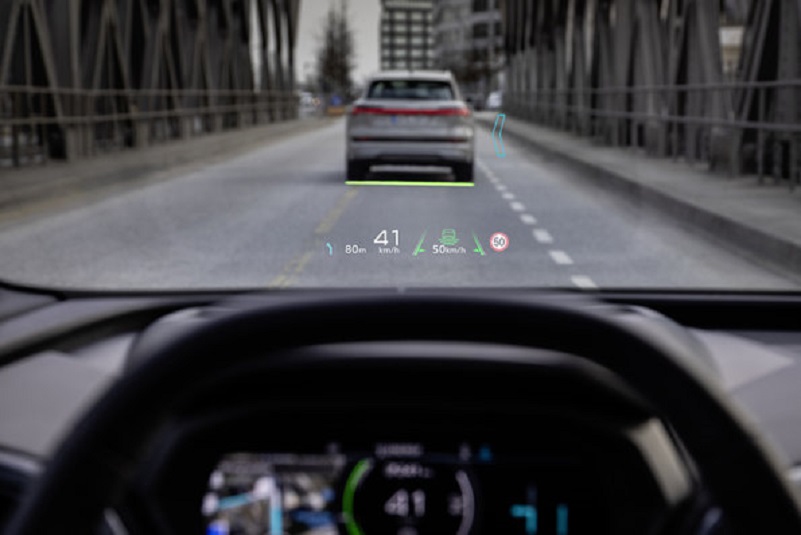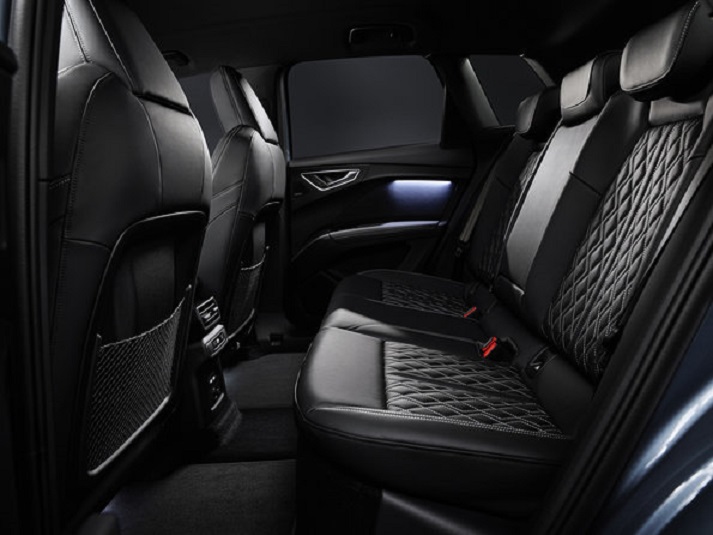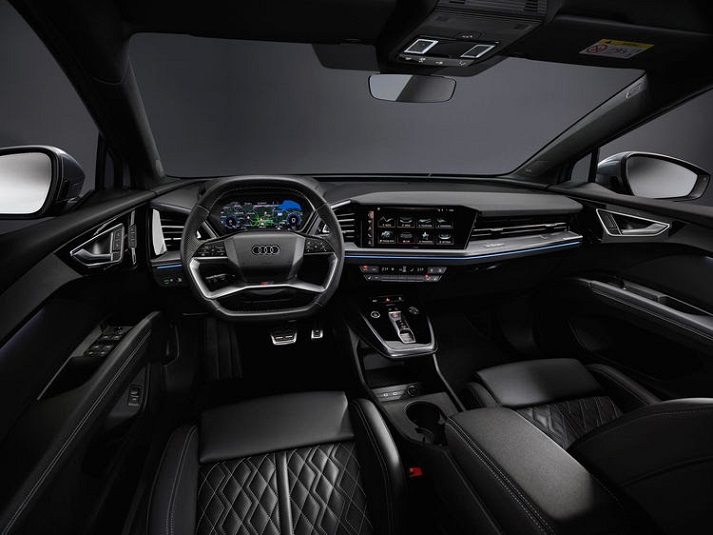
Spaciousness of the compact e-model exceeds the benchmark of its class
Augmented reality head-up display as pioneering display technology
New steering wheel generation with touch operation, MMI display with a diagonal of up to 11.6 inches
Welcome aboard: The driver and passengers experience entirely new dimensions in the new Audi Q4 e-tron. The spaciousness of the electric compact SUV far exceeds the current class boundaries, and offers an amount of space comparable to that offered in the full-size class.
The display concept has also reached a new dimension: The augmented reality head-up display brings the real and virtual worlds together, and the MMI display has a diagonal of up to 11.6 inches (option will be available around the end of the year).
The new steering wheel generation with touch operation represents the new electric model’s course for the future. In terms of stowage compartments, the Audi Q4 e-tron scores high with a total volume of around 25 liters (0.9 cu ft), and the bottle holders in the top section of the doors are a further highlight. The airy and progressive interior design allows customers to experience the new technology era.
New and cleverly solved: the packaging
With the Q4 e-tron, Audi is presenting a true all-rounder – it is a confident companion for everyday life and leisure, and is suitable in every way as a household’s main car. At 4,590 millimeters (15.1 ft) long, 1,865 millimeters (6.1 ft) wide, and 1,613 millimeters (5.3 ft) high, the exterior dimensions of the Q4 e-tron place it in the larger compact SUV segment.
The architecture of the modular electric drive system (MEB) on which the compact electric SUV from Audi is based enables a completely new division of space. While the front overhang measures just 86 centimeters (33.9 in), the wheelbase measures a generous 2.76 meters (9.1 ft) – even more than in the medium-sized SUV segment. The resulting interior measures 1.83 meters (6.0 ft) in length, which is similar to a large full-size class SUV.
Welcome aboard: comfortable entry, generously spacious
Even getting into the Audi Q4 e-tron is a comfortable experience: The doors open wide, and the seats are in a comfortably high position. The driver and up to four passengers enjoy a generously spacious interior, made possible in part by the fact that there is only a flat step instead of a center tunnel.
The seat position in the second row is almost seven centimeters (2.8 in) higher than at the front, while still offering plenty of headroom – and the knee room is positively luxurious. When it comes to spaciousness, the compact electric SUV from Audi surpasses its direct competitors in the premium segment.
A wealth of storage compartments: 24.8-liter (0.9 cu ft) volume and ergonomic bottle storage
As a true all-around vehicle and family car, the Audi Q4 e-tron comes with a generous amount of storage compartments, which add up to a volume of 24.8 liters (0.9 cu ft) including the glove compartment. The center console integrates two cup holders, a 4.4-liter (0.2 cu ft) stowage compartment with a cover, two (or four as an option) USB type-C sockets, and the Audi phone box for the mobile phone upon request.
All four door trims feature holders for bottles holding up to one liter that are located far up in the front section of the armrest and are therefore very easy to reach. The upper bottle holders were developed in close cooperation between designers and engineers; finding a spot for them in the limited door space was a real challenge.
The luggage compartment of the Audi Q4 e-tron provides 520 liters (18.4 cu ft) of space for luggage. Folding down the backrests, which are divided in the ratio 40:20:40, creates a virtually level surface; when loaded to the roof, the luggage compartment provides a volume of 1,490 liters (52.6 cu ft).
This corresponds to the level of the next-higher SUV segment. Audi also provides a partition net and luggage compartment package upon request. It includes a loading floor that can be inserted at two height levels, for example.
Fully digital at four levels: the operating concept
Just as in all of its models, Audi is relying on a fully digital operating and display concept with a flat menu structure in the Q4 e-tron as well. It comprises four levels: the digital instrument cluster or Audi virtual cockpit for the driver, the central MMI touch display, the natural-language voice control, and the optional augmented reality head-up display – it is a new pioneering piece of technology.
A new dimension: the augmented reality head-up display
With the optional augmented reality head-up display in the Q4 e-tron, Audi is taking a huge step forward in display technology. It reflects important information via the windshield on two separate levels, the status section and the augmented reality (AR) section. The information provided by some of the assist systems and the turning arrows of the navigation system as well as its starting points and destinations are visually superimposed in the corresponding place on the real-life outside world as content of the AR section and displayed dynamically.
They appear to be floating at a physical distance of roughly ten meters (32.8 ft) to the driver. Depending on the situation, they appear considerably further ahead in some cases. The driver can understand the displays very quickly without being confused or distracted by them, and they are extremely helpful in poor visibility conditions.
The field of view for the AR content from the driver’s perspective corresponds to a diagonal of around 70 inches. Below it is a flat near-field area window, known as the status section. It displays the speed driven and the traffic signs as well as the assist system and navigation symbols as static displays that appear to be floating roughly three meters (9.8 ft) ahead of the driver.
The heart of the system: the picture generation unit
The technical heart of the augmented reality head-up display is the picture generation unit (PGU), which is located deep inside the long instrument panel. A particularly bright LCD directs the light beams it generates onto two level mirrors, and special optical components separate the portions for the near-field and distant areas. The level mirrors direct the beams onto a large concave mirror that can be adjusted electrically.
From there, they reach the windshield, which reflects them into what is known as the eyebox, and thus onto the driver’s eyes. At an apparent distance of ten meters (32.8 ft), or even further away depending on the situation, the driver sees the symbols just as clearly as their real-life environment.
Predictive picture generator: the AR Creator
What is known as the AR Creator serves as the mastermind and picture generator on the software side. It is a processing unit in the modular infotainment platform (MIB 3) that is comprised of multiple individual modules. The AR Creator renders the display symbols at a rate of 60 frames per second and adapts them to the geometry of the projection optics.
At the same time, it calculates their location in relation to the environment, on which it obtains information via the raw data of the front camera, the radar sensor, and the GPS navigation. Its software consists of roughly 600,000 lines of programming code, around 50 percent more than the entire control system of the first version of the Space Shuttle.
While performing its computing work, the AR Creator takes into account that there are always a few fractions of a second between the identification of an object by the sensors and the output of the graphic content. During these brief time windows, the Q4 e-tron can change its position considerably, be it due to braking or a pothole. Multiple computations are performed continuously to ensure that the display in the eyebox does not jump into the wrong position.
One of them takes place in the camera software. For another, the AR Creator uses the most recent data to make a predictive calculation of the car’s continued forward movement. In a further computation, it estimates the vertical movement on the basis of data supplied by the camera, the radar and the sensors of the stabilization control (ESC).
These insights are incorporated into the “shake compensation,” which takes place a few milliseconds before the picture is output and whose task is to prevent any disruptive shaking of the display.
Navigation: the drone flies ahead
The augmented reality head-up display demonstrates its strengths in a particularly impressive way in the context of navigation. On the road, what is known as the drone – a floating arrow – shows the next point of action on the route. It is dynamic: When approaching an intersection, for example, the floating arrow first announces the turning maneuver before an animated arrow steers the driver onto the road with precision.
If the route then continues straight ahead, the drone flies ahead and disappears in order to then reappear with sufficient time before the next point of action. The distance to the turning point is displayed in meters in the lower window of the near-field area.
Even if the driver activates the adaptive cruise assist, which keeps the car in the center of the lane, the augmented reality head-up display assists them with visual hints. As soon as the Audi Q4 e-tron approaches a lane marking without the turn signal having been activated, the lane departure warning superimposes a red line on the real-life lane marking.
Another example is in relation to a vehicle driving in front: If it is active, the car is marked on the display with a colored stripe – this allows the driver to understand the status of the adaptive cruise assist or adaptive cruise control without being distracted. A red marking and a warning symbol appear if the adaptive cruise assist prompts the driver to verify that they are paying attention.
Three variants: the digital cockpit
The standard digital instrument cluster has a 10.25-inch diagonal and is operated via the multifunction steering wheel. The power meter, which is located next to the speedometer on the display, summarizes all important information on the drive, from the output and the state of charge of the battery in percent, and all the way to recuperation.
The Audi virtual cockpit is the first option level. It integrates the navigation map and infotainment control and can be switched between two views. The Audi virtual cockpit plus is the top-of-the-line version. It offers the “classic,” “sport,” and “e-tron” layouts, where the power meter plays the main part. Many displays can be configured freely via the MMI here.
Up to 11.6-inch diagonal: the central MMI touch display
The MMI touch display with acoustic feedback has a 10.1-inch diagonal and a resolution of 1,540 x 720 pixels. It is configured as an MMI radio plus with DAB reception as standard, and is used to control the infotainment system as well as a number of comfort functions.
In addition, it allows text input in handwriting. In the optional large version, the display comes with an 11.6-inch diagonal and a resolution of 1,764 x 824 pixels. It is the largest display in the Audi portfolio to date and will be available at the end of the year.
Good understanding: voice control
The natural-language voice control, which is activated with the keywords “Hey Audi,” is the third control level in the Audi Q4 e-tron. It understands many entries and requests in everyday language, for example “Where is the nearest charging station?” If MMI navigation advanced is on board, it performs an online comparison in many cases.

Progressive and airy: the interior design
The new era of technology into which Audi has entered is also reflected in the interior of the Q4 e-tron. The instrument panel presents itself with progressive elegance and underlines the airy feeling of spaciousness. The cockpit features a markedly three-dimensional design, and its geometric volumes are interrelated in an electrifying way.
In the Audi Q4 e-tron, the operating and display units take on the function of design elements more than ever. The digital instrument for the driver is embedded like a diamond between two volumes – a short one on the left-hand side, which incorporates an air vent, and a long one on the right-hand side. It extends all the way to the front passenger door and integrates further air vents. The central MMI touch display, which appears clean and light, occupies the space in front of it. It is tilted toward the driver and well placed for ergonomic accessibility.
A lean inlay, which is known as the tech layer, lies above the display and connects it with the instrument panel. The choice of surface materials for the panel includes open-pore lime wood, aluminum in two different designs, and plastic. A technical hybrid fabric that is made partially from recycled material will be available for the inlay of the interior S line shortly after the market launch.
Depending on the equipment package, the further contours of the instrument panel, which are known as accent surfaces, are designed in various silver and gray tones to match the inlay.
The most striking of these contours runs across horizontally, dividing the instrument panel into two zones, and is decorated with a distinctive e-tron badge. Immediately below it, also facing the driver, lies the operating unit for climate control. Below it, a large operating panel with a black-panel look extends into the space.
It holds the compact shifter for selecting the gears, a capacitive rotary volume control, the start/stop button, the hazard warning light switch, and the Audi drive select button. In addition, there are buttons for further functions that are designed as seamless touch surfaces in a black-panel look and backlit with white light.
The future in our hands: steering wheels with touch operation
The steering wheels in the Audi Q4 e-tron are also setting course for the future of mobility. With their double-spoke design, they belong to a new generation. The Four Rings on the impact absorber feature a flat design, and the bottom spoke bears the e-tron logo. The upper spokes feature touch surfaces in a black-panel look whose functional areas are also backlit to indicate the respective active buttons.
Slight protrusions separate them from each other, thereby making them easier to use, and the buttons provide soft haptic feedback when pressed. As on a smartphone, there are not only touch gestures but also swipe gestures, for example for scrolling through lists.
The steering wheels are available in different versions. The top-of-the-range version features paddles affixed to the steering wheel for coasting recuperation and a two-part trim on the spokes. The heated rim is flattened at the top and bottom here – a solution that makes the interior ambiance seem even more futuristic. Be it look, function, or feel – the new steering wheel clearly expresses the progressive character of the Q4 e-tron.
Excellent safety: the front seats
The front seats in the Q4 e-tron represent the state of the art in terms of safety technology. In the event of a side impact, what is known as the center airbag unfolds from the right-hand bolster of the driver’s seat in addition to the side airbags to ensure that the driver and front passenger do not collide with one another. Seat heating, electric adjustment, and electric lumbar support are available as an option. The seats are available in a basic version and a sport version with visually integrated head restraints, and optionally with a rhombus pattern.
When it comes to interior colors, customers can choose between black, steel gray, Santos brown, or pergament beige. The total of nine equipment packages also includes a stitching package. Five packages are available for the basic version, while the other four are available for the interior S line. They differ with regard to the door sill trims, the paint color of the accent surfaces, the material of the armrests, and the headlining.
All optional equipment packages for the interior include white LED lighting, or, alternatively, the multicolor ambient lighting package plus. Some features are reserved exclusively for the interior S line: illuminated aluminum door sill trims, pedals with stainless steel supports, a black headlining, S embossing in the seat backrests, a steering wheel rim made of perforated leather with contrasting stitching, and S badges.
Dinamica and Puls: seat upholstery made with recycled polyester
The interior S line also has a great deal to offer in terms of upholstery materials. Customers who prefer traditional materials can choose between a leather/artificial leather mixture and the premium fine Nappa leather. The combination of artificial leather and the microfiber material Dinamica is another novel variant. It looks and feels like suede but is made of 45 percent recycled polyester, which is sourced from textiles and PET bottles, for example.
The Puls upholstery, also in combination with artificial leather, is a further option for the interior S line. Secondary raw materials are used here, too: Up to 50 percent of the textile used consists of recycled PET bottles, which are transformed into yarn in an elaborate procedure. This results in a material that has the same quality standards in terms of look and feel as conventional textile upholstery. In a set of seats for the Q4 e-tron, 26 1.5-liter plastic bottles are given a new purpose.
Audi goes electric: the Q4 e-tron is being launched in a dynamic market segment
The electric offensive at Audi continues to pick up steam. The Q4 e-tron follows the large SUV models e-tron and e-tron Sportback, as well as the sporty e-tron GT. The Q4 e-tron plays a key part in the brand’s electrification strategy.
It is being launched in a particularly attractive and fast-growing market segment, the class of compact SUVs. For Audi customers, it offers an entry into the world of electric premium mobility at an attractive price.

































